Learning how to get a freight quote involves shopping around and deciding among different provider options, giving them accurate shipment details, and finally booking your shipment.
There are multiple options for comparing carriers to find the best rate—and an accurate quote depends on many variables.
One of the best ways to get a freight quote is through NTG (formerly FreightPros). As a freight broker, it gives you fast quotes from vetted and qualified freight carriers with deep discounts and the peace of mind of knowing your freight will be delivered safely and on time. Check out NTG for a fast, free quote.
This guide shows you how to get shipping quotes in four simple steps:
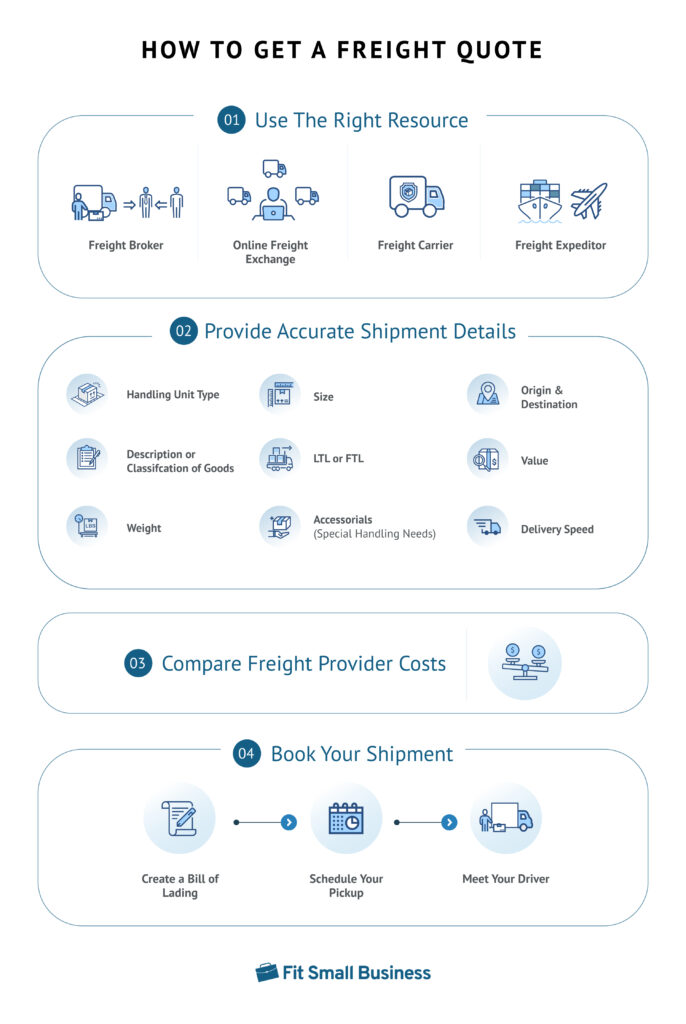
Step 1: Decide Where to Get a Freight Quote
The right shipping partner makes quoting and shipping freight easy. You can go straight to a freight carrier to get a quote or use a freight broker or online exchange website to compare quotes from multiple carriers. In any case, you want to ensure you’re getting a good deal and that your freight is in good hands.
Compare Different Freight Provider Options
To decide where to get a freight quote, acquaint yourself with different freight providers and see which ones look like a good solution for your business needs. Most providers offer free quotes, so shop around to determine which will provide you with the best rate.
We outline four main types of freight providers below.
Freight Provider Type | What They Do | Best For | Examples |
|---|---|---|---|
Freight Broker | Acts as a middleman between businesses and shipment carrier | Occasional and regular shippers wanting competitive prices and hands-on customer service | |
Online Freight Exchange | Similar to online DIY brokers, such as an auction house or a social network that directly connects shippers with carriers | One-time or repeat shippers that want total control over their shipping options | |
Independent Nationwide or Regional Carrier | Direct shipper | Repeat shippers with freight traveling on specific nationwide lanes or within a specific region | |
Freight Expeditor | Facilitate global freight shipping, like shipment brokerage, freight forwarding services (customs documentation and movement coordination) | Shippers exporting or importing freight |
Freight brokers are a popular choice because their experience and service can help save time and money. They are the experts regarding carrier reliability and the ins and outs of National Motor Freight Classification (NMFC) codes (which we discuss in detail later).
Freight brokers are experienced shipping professionals that tap into many carriers to find the best rate for your shipments, making it ideal for new and infrequent shippers. They also have excellent websites that allow frequent shippers to manage their accounts—from getting freight quotes and booking carriers to tracking freight shipments.
Considered the technology-driven new kids on the block, freight sites are online do-it-yourself broker services that bring wholesale carrier prices straight to you. Freight company quotes used to be exclusive to freight brokers and other industry pros before exchanges were born.
Using a freight exchange can be a great way to get a competitive quote for shipping if you have a straightforward shipment that’s not time-critical. Some online freight exchanges, like uShip, have intuitive online tools that walk you through the entire process in minutes. They also have excellent online user reviews.
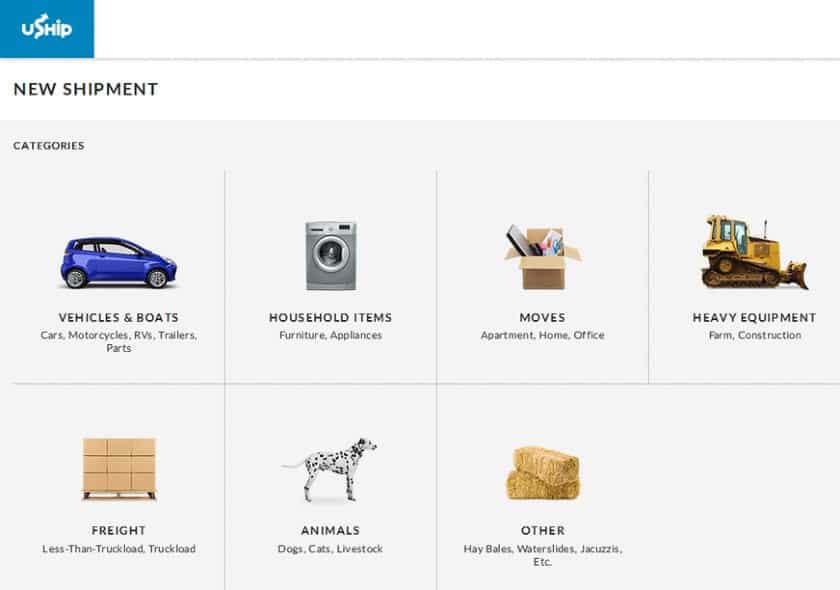
uShip’s user-friendly website makes getting a freight quote easy—even for first-time shippers.
However, issues like product class and accessorial fees can be confusing if you have special handling needs or are new to freight shipping. A top-rated freight broker can answer all these questions and ensure a smooth delivery.
These providers are your household carrier names—UPS and FedEx, along with names like Central Freight, R&L Carriers, Saia, and many more. Just glance around next time you’re on the freeway, and you’ll see a truck from an independent carrier.
Some carriers ship nationwide, while others specialize in a specific region. If you ship in volume along certain routes or within a region, you can negotiate lower rates directly with a specific carrier.
Freight expeditors are brokers that specialize in import and export shipments. Their services often include freight forwarding—preparation, organization, and coordination of the movement of commodities across borders.
Large international third-party logistics (3PL) companies specialize in these services, and some freight brokers and independent carriers also offer expeditor services. Through expeditors, you can get air and ocean freight quotes for any export shipping need.
Step 2: Gather All Your Shipment Details
Now that you know where to get a freight quote, you’ll need to provide detailed information about your shipment. The most important thing to remember here is to be accurate! If you provide incorrect details on weight, size, or items shipped, you could end up paying more than you should.
Here are the data points shipping providers need to give you an accurate quote:
A shipment’s handling unit consists of packaging materials and the goods contained in (or on) it. Carriers need to know what type of packaging they’ll be transporting to properly assess cost.
Goods are commonly stacked onto pallets, but other handling units include boxes, crates, barrels, and reels. If a material is shipped without packaging, its handling unit is described as “loose.”

Freight shipments often use wrapped pallets (left), wood crates (center), or corrugated containers (right).
Source: Global Industries
Correct shipment classification has a great impact on freight price. If not described correctly, chances are you could receive an incorrect freight quote and see upcharges on your final bill once shipped.
Freight packages are identified using NMFC codes. Classifications are based on which goods are easier, less fragile, and safer than others—and thus less expensive to ship. This is a tricky area to navigate since NMFC code assignments can seem arbitrary, even to experienced shippers. But it matters because these codes (together with the size and weight of your shipment) determine your freight class.
Freight classification is a complex system determined by commodity, density, handling, stowability, and liability—but to get a freight quote, what you really need to know is this:
- Freight classes are numbered from 50 to 500
- The lower the class, the lower your shipping rate
- Class can be based on the goods you’re shipping, as determined by the NMFC code
- Class can be based on shipment size and weight, called density-based class
- Your shipping partner can help you determine how your freight should be classed
If you don’t know your goods’ freight classification, your broker or carrier can still provide you with a quote based on the shipment’s physical attributes along with a description of its contents.
If you’re shipping boxed items on a pallet, or bagged goods in a container, this value is pretty easy to figure out. Just weigh your items individually and add all of the weights together; a shipping or postal scale works fine for this.
Don’t forget to add the weight of your pallet or freight container to your total! A safe rule of thumb for pallet weight is 40 lbs, but the weight of crates and other containers can vary. Weigh crates if possible—or if you build them yourself, weigh individual pieces before assembly.
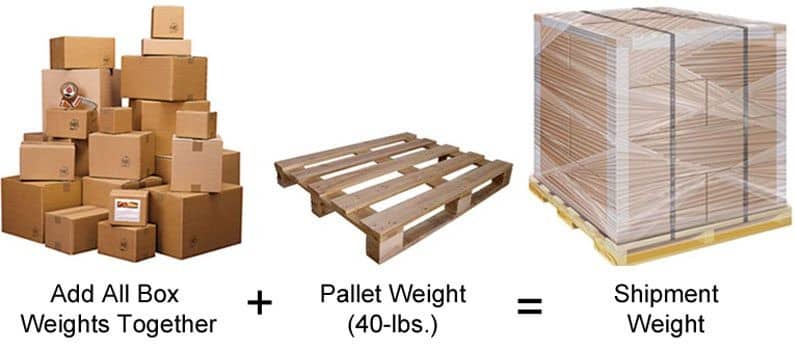
The weight of a freight shipment accounts for goods as well as packaging materials. (Source: Global Industries)
If you’re shipping a multi-piece freight shipment, simply add the weights of each packed unit together, like this:
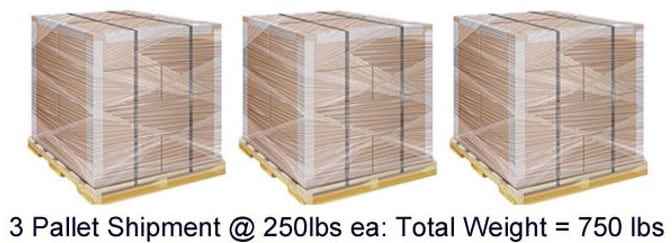
(Source: Global Industries)
If you’re shipping an enclosed crate, this value is easy to find. Simply measure the length, width, and height of your crate.
It gets trickier if you’re shipping a pallet and haven’t stacked it yet. If you have a pallet and the product available, you can stack it and measure the finished length, width, and height, like this:
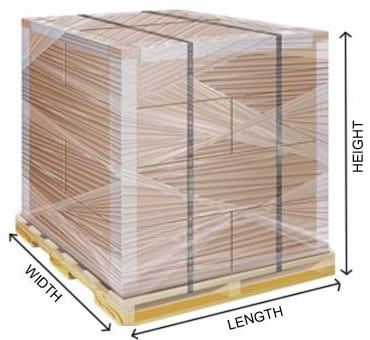
(Source: Global Industries)
If you don’t have a pallet yet, you can stack your product on the floor. Mark or tape off a 40” x 48” square (most pallets are close to this size). Then stack your boxes, making your layers close to the edges of your square.
Once your boxes are stacked on the floor, measure the length, width, and height, and add 6” to the height to cover the height of the pallet.
For multi-piece shipments, measure the width, height, and length of each piece, then add all of the lengths together to get the total size of the shipment, like this:
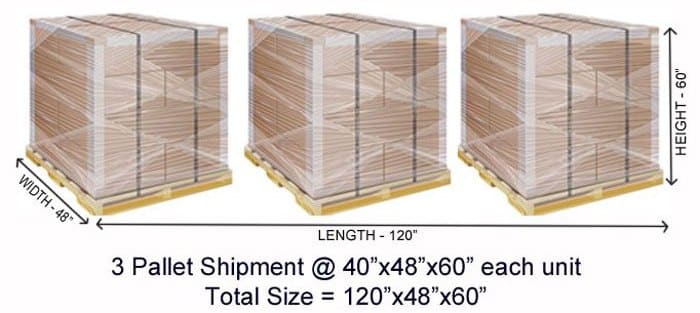
(Source: Global Industries)
The size and weight details we covered above let you determine the type of freight you’re shipping, LTL or FTL. These are priced at different rates, so it’s important to know the total size of your shipment to get the right freight quote.
- LTL (Less-than-load): Usually one to six pallets or similarly-sized units and doesn’t fill the majority of the space in a freight truck; most common type of freight shipping
- FTL (Full-truck-load): Seven or more pallets or similarly-sized units and will fill most or all of the space in a freight truck; midsize shipments are sometimes called partial truck loads
As a rule, the more demanding the load and the service, the higher the cost. Here are a few special handling charges that can add costs to your freight quote. These are called accessorial fees and are usually itemized on both your freight quote and your final bill:
- Residential delivery: Delivering to a residence is generally more costly than delivering to a business. Plus, a liftgate is usually required.
- Liftgate service: If there is no delivery dock or forklift available at pickup or delivery, a liftgate is required to load and unload truck shipments.
- Appointment delivery: Delivery appointments can be made to meet your pick-up or customer’s delivery needs, usually with a fee.
- Trade show delivery: Deliveries to trade show locations sometimes require scheduled deliveries and other destination services, such as inside delivery and signature by a specific receiver. These service add-ons usually come with additional fees.
- Refrigeration truck: Called reefer trucks in industry lingo, refrigerated shipments or reefer freights enjoy climate-controlled transit end-to-end, at a cost.
- Hazardous materials (hazmat) transportation: Hazmat shipments fall under their own set of transportation restrictions and additional fees.
If you’re unsure if your shipment requires special handling, your freight broker or carrier rep can help you.
When you request a freight quote, you won’t be asked for the full address until you’re ready to book the shipment. However, you’ll need to know the type of delivery location (residential or business), plus which special handling needs apply—such as a liftgate.

The freight quote screen for uShip makes it easy to enter all of the shipment details we discuss in this guide, including the pickup and delivery ZIP codes, and any special services.
The value of your freight usually doesn’t affect freight quotes unless you wish to purchase insurance beyond the carrier’s liability insurance.
That said, basic freight liability insurance may not cover your complete replacement costs in the event your freight is lost or damaged during shipment. So, additional insurance can be a good idea, and some carriers require it for high-value shipments, typically around $15,000 or more. You can get an idea of how it works by reading our freight and cargo insurance guide.
Most freight providers make it easy to add insurance to your shipment when you get a freight quote. Simply provide the shipment value when you enter your other shipment details, and they will include an insurance cost, which you can elect or decline, as shown below:
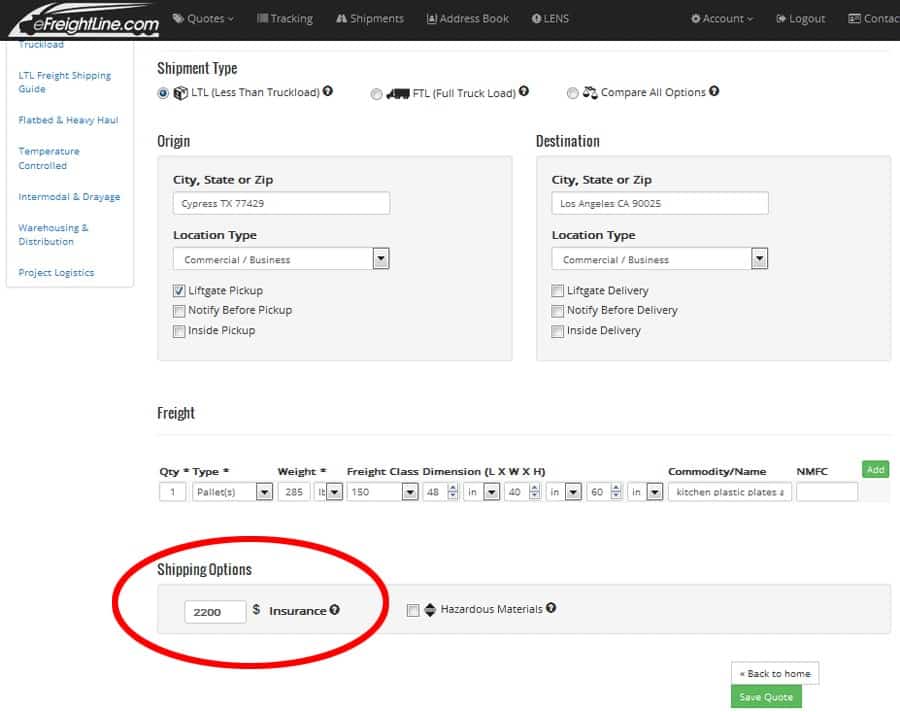
Adding insurance on to a freight quote on eFrieghtline.com
The cost to insure a freight shipment can vary based on many factors—such as the carrier, the goods being shipped, the shipping routes, packaging type, and so on. But it’s usually a reasonable price, and we recommend purchasing insurance when possible.
Freight carriers have different names for the service types that determine delivery speed, but they typically fall under three timeframes:
- Standard: Ground transit time, which can differ by carrier and take a day or two longer than published times and not be considered late. This is the norm in the freight industry.
- Expedited/Express: Faster delivery at an additional cost, but delivery times can vary per carrier as much as one to two days.
- Guaranteed: Additional payment for a guaranteed delivery date and a scheduled delivery appointment time; worth the price for date-critical shipments, such as trade show displays or special event needs.
Delivery times can vary by days depending on the carrier. Remember, only Guaranteed Freight with additional charges is guaranteed to arrive on a certain day.
When you get a freight quote, you’ll see both prices and transit times, as shown in the image below. These are delivery estimates, not guarantees.
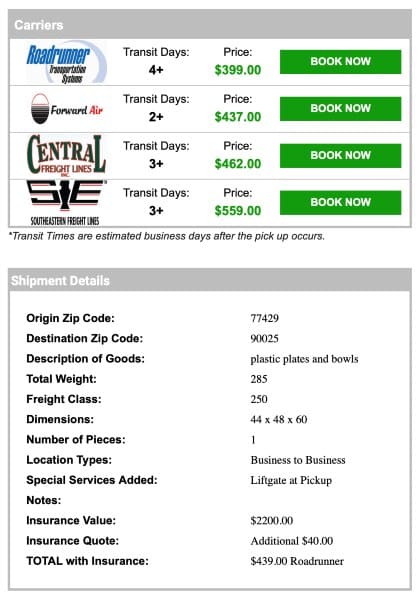
A sample quote offering from uShip
Distances & Travel Times for Freight Quotes
The distance your freight travels is a big factor in your freight quote—but surprisingly, long distances don’t necessarily equal higher costs, or even longer delivery times.
Within the US, freight carriers operate via commercial routes called lanes, and some are faster and cheaper than others.
Depending on where you’re shipping from and to, lanes to closer destinations can be more expensive than lanes to farther destinations. Plus, shipments to large cities far away can be faster than those to small towns that are closer.
For example, shipping from Houston, TX, to New York City (1,628 mi) is generally less expensive and faster than shipping to Los Angeles (1,546 mi). So if you notice this as you get freight quotes for different destinations, don’t be surprised.
If you’re shipping freight out of the country, your best bet is to work with a freight expeditor to handle all of your cross-border export/import tasks.
Request a freight quote from several providers once you have all your shipment details ready. Most freight providers have links on their websites where you can enter your shipment details to request a quote.
Step 3: Compare Freight Provider Costs
After giving all of the freight details above to your shipping provider, you’ll receive your quote. Depending on your provider and the service you need, you may receive just one price or several to choose from.
To give you an idea, we requested a freight quote from a broker and an independent carrier using the shipment details below. All of these were easily done online through the provider’s website.
Note: We also requested a quote through an online freight exchange (uShip) but haven’t received a response.
- 285-lb shipment
- Shipping from Houston to Los Angeles
- Delivering to a residential address
- Using a liftgate on delivery
- Standard freight (48″ x 40″ x 38″)
- Class of 150 (contains furniture such as bookcases)
- Est. 3+ transit days
Freight Resource | Freight Quote |
|---|---|
Freight Broker (NTG/FreightPros) | $581.00 |
Independent Carrier (TForce Freight) | $1,036.76 |
When you receive the freight quotes, compare the costs to see which one fits your budget. What is also worth noting is that a competent freight broker should also offer assurance that your freight will be delivered safely and on time. For example, NTG provides its customers with freight pickup times, shipment tracking, GPS truck tracking, easy freight quotes, and more.
Once you’ve settled on the price and service, review the details with your provider to make sure it’s all in order. Then you’re ready to move to the final step.
Step 4: Book Your Shipment
The good news is that once you’ve gotten through the quote process, the rest is pretty simple—now you just need to book your shipment.
If you use a broker, exchange, or carrier website, this usually happens with a few simple clicks. If you received a quote via email from a broker or carrier, then you just need to respond to them.
After that, completing your shipment requires the following steps:
A Bill of Lading, or BOL, is the freight shipment paperwork. It contains all the needed information to describe, track, and deliver a freight shipment—ship-from and deliver-to addresses, contact phone numbers, shipment contents, freight weight, class, size, number of shipped units, service level, special services, and the freight tracking number (PRO number).
When booking your shipment, you’ll enter your delivery address information online or provide it to your rep via email or phone. The BOL paperwork will be created with this information. Before printing, be sure to double-check that the address, class, weight, and any special charges are correct per your quote.
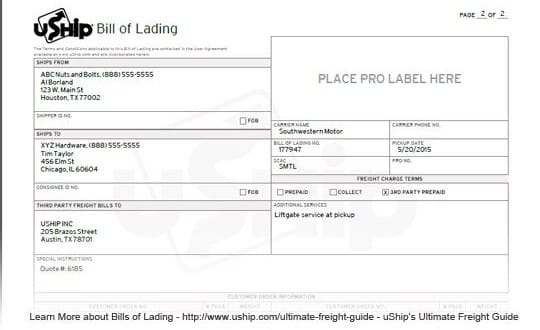
An example of a BOL generated by uShip
If the BOL is in order, attach it to your packed freight shipment as instructed by your shipping provider. Usually, this goes in a clear plastic resealable envelope that adheres to the outside of your shipment.
Upon booking, you’ll also schedule the pickup day and time. Freight carriers typically deliver in the morning and pick up in the afternoon. Be sure to note your available pickup times so your truck driver arrives while you’re open. Add in a buffer, as drivers can run late.
Have your freight shipment packed and waiting in an area the driver can access with the truck. If you have a loading dock, your driver will load your freight from there. If you don’t have a loading dock and access to a forklift, you should add liftgate service at pickup to your quote to be certain you can get your freight loaded.
Your driver will review your BOL and sign off on the pickup day and time prior to loading. If you have two copies, the driver will leave a signed one for you as proof of pickup. After that, your freight is on its way, and you can track the progress online on your broker, carrier, or exchange website.
Bottom Line
Getting the best freight quote isn’t hard if you have accurate information about your shipment and a reliable freight provider. You can get freight quotes and book your shipments through a number of sources—including freight brokers, online freight exchanges, independent carriers, and freight expeditors for import and export needs.
Of these, freight brokers tend to be the best bet for price and service, especially if you’re new to shipping freight.
We recommend looking into NTG (formerly FreightPros). With NTG, you get fast, accurate freight quotes and a support team that works on your specific shipping needs. Visit NTG for a free quote.